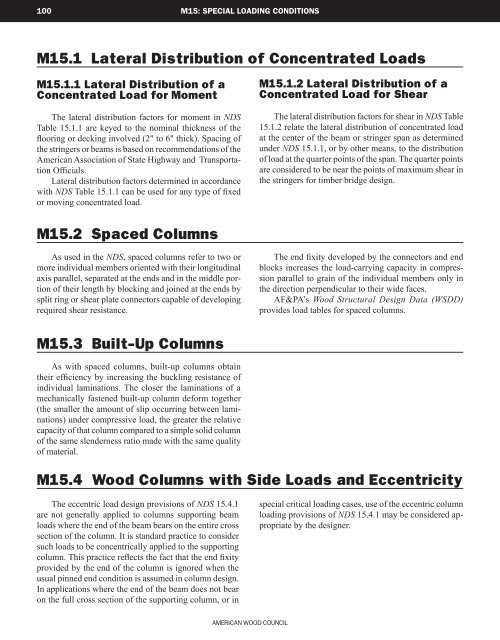ASD/LRFD Manual - American Wood Council
ASD/LRFD Manual - American Wood Council
ASD/LRFD Manual - American Wood Council
Create successful ePaper yourself
Turn your PDF publications into a flip-book with our unique Google optimized e-Paper software.
100 M15: SPECIAL LOADING CONDITIONS<br />
M15.1 Lateral Distribution of Concentrated Loads<br />
M15.1.1 Lateral Distribution of a<br />
Concentrated Load for Moment<br />
The lateral distribution factors for moment in NDS<br />
Table 15.1.1 are keyed to the nominal thickness of the<br />
flooring or decking involved (2" to 6" thick). Spacing of<br />
the stringers or beams is based on recommendations of the<br />
<strong>American</strong> Association of State Highway and Transportation<br />
Officials.<br />
Lateral distribution factors determined in accordance<br />
with NDS Table 15.1.1 can be used for any type of fixed<br />
or moving concentrated load.<br />
M15.1.2 Lateral Distribution of a<br />
Concentrated Load for Shear<br />
The lateral distribution factors for shear in NDS Table<br />
15.1.2 relate the lateral distribution of concentrated load<br />
at the center of the beam or stringer span as determined<br />
under NDS 15.1.1, or by other means, to the distribution<br />
of load at the quarter points of the span. The quarter points<br />
are considered to be near the points of maximum shear in<br />
the stringers for timber bridge design.<br />
M15.2 Spaced Columns<br />
As used in the NDS, spaced columns refer to two or<br />
more individual members oriented with their longitudinal<br />
axis parallel, separated at the ends and in the middle portion<br />
of their length by blocking and joined at the ends by<br />
split ring or shear plate connectors capable of developing<br />
required shear resistance.<br />
The end fixity developed by the connectors and end<br />
blocks increases the load-carrying capacity in compression<br />
parallel to grain of the individual members only in<br />
the direction perpendicular to their wide faces.<br />
AF&PA’s <strong>Wood</strong> Structural Design Data (WSDD)<br />
provides load tables for spaced columns.<br />
M15.3 Built-Up Columns<br />
As with spaced columns, built-up columns obtain<br />
their efficiency by increasing the buckling resistance of<br />
individual laminations. The closer the laminations of a<br />
mechanically fastened built-up column deform together<br />
(the smaller the amount of slip occurring between laminations)<br />
under compressive load, the greater the relative<br />
capacity of that column compared to a simple solid column<br />
of the same slenderness ratio made with the same quality<br />
of material.<br />
M15.4 <strong>Wood</strong> Columns with Side Loads and Eccentricity<br />
The eccentric load design provisions of NDS 15.4.1<br />
are not generally applied to columns supporting beam<br />
loads where the end of the beam bears on the entire cross<br />
section of the column. It is standard practice to consider<br />
such loads to be concentrically applied to the supporting<br />
column. This practice reflects the fact that the end fixity<br />
provided by the end of the column is ignored when the<br />
usual pinned end condition is assumed in column design.<br />
In applications where the end of the beam does not bear<br />
on the full cross section of the supporting column, or in<br />
special critical loading cases, use of the eccentric column<br />
loading provisions of NDS 15.4.1 may be considered appropriate<br />
by the designer.<br />
<strong>American</strong> <strong>Wood</strong> <strong>Council</strong>

















